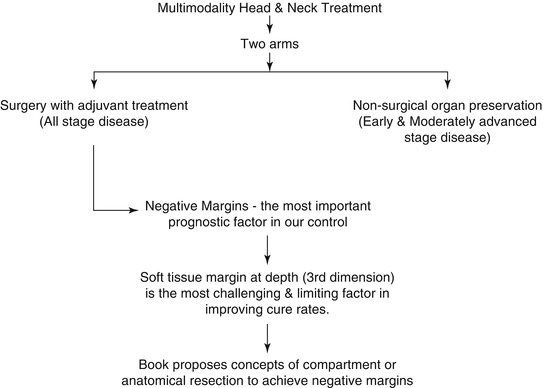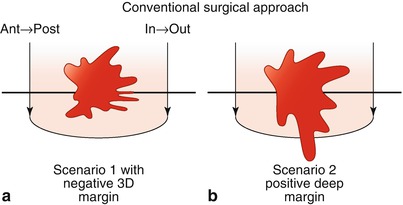(1)
Narayana Hridayalaya Multispeciality, Bangalore, India
The Compartment Surgical Approach
The entire anatomical compartment containing tumor is removed instead of removing tumor with one cm margin. The compartment is defined on the basis of anatomy of the site and pattern of tumor spread.
Treatment algorithms are continuously evolving in the era of multimodality treatment. There are two major approaches that define treatment of head–neck cancer (Fig. 1.1). The conventional approach of surgery with adjuvant treatment has been in practice since long and can be used for any stage of disease. The newer nonsurgical organ preservation approach is best suited for relatively early disease and moderately advanced stage disease. It is also necessary to remember that salvage surgery still remains an essential part of nonsurgical approach.


Fig. 1.1
Multimodality head and neck treatment
The new surgical technologies (laser, robot) and improved reconstructive techniques have reduced the procedure-related morbidity to a significant extent. It is essential to understand that the oncological principle of achieving negative margins in all direction still forms the basis of any surgical treatment. It is the most important prognostic factor that can influence the outcome. To achieve negative margins at depth (the 3rd dimension) is the most challenging and limiting factor in improving local control rate. This book proposes a novel surgical concept – compartment resection – to consistently achieve negative margins for soft tissues in depth (3-D).
Figures 1.2, 1.3, 1.4, and 1.5 show the difference in concept between conventional and this novel approach. In conventional surgical approach, dissection starts from mucosa and moves out to clear involved soft tissues. This is also called in-to-out approach (Fig. 1.2a). There is potential of leaving some disease behind for large and deeply infiltrative tumors with this approach (Fig. 1.2b). The surgeon always worries about injuring neurovascular bundle at depth, and this may restrict wide clearance in deeper areas like the infratemporal fossa (ITF) and tongue base. The final result also varies with the skill level of the operating surgeon.
 < div class='tao-gold-member'>
< div class='tao-gold-member'>





Only gold members can continue reading. Log In or Register to continue
Stay updated, free articles. Join our Telegram channel

Full access? Get Clinical Tree


